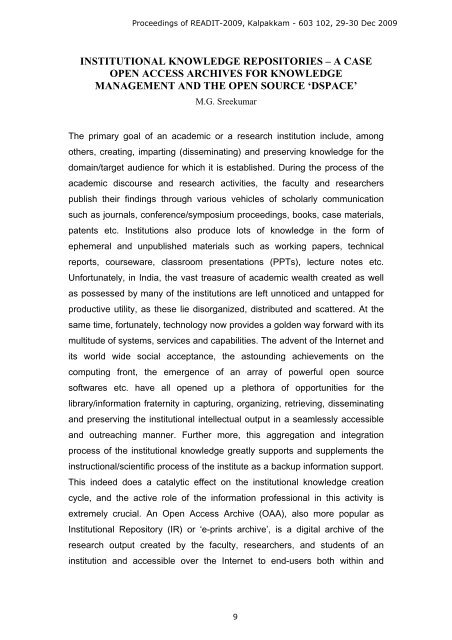READIT - 2009 - Indira Gandhi Centre for Atomic Research
READIT - 2009 - Indira Gandhi Centre for Atomic Research
READIT - 2009 - Indira Gandhi Centre for Atomic Research
You also want an ePaper? Increase the reach of your titles
YUMPU automatically turns print PDFs into web optimized ePapers that Google loves.
Proceedings of <strong>READIT</strong>-<strong>2009</strong>, Kalpakkam - 603 102, 29-30 Dec <strong>2009</strong><br />
INSTITUTIONAL KNOWLEDGE REPOSITORIES – A CASE<br />
OPEN ACCESS ARCHIVES FOR KNOWLEDGE<br />
MANAGEMENT AND THE OPEN SOURCE ‘DSPACE’<br />
M.G. Sreekumar<br />
The primary goal of an academic or a research institution include, among<br />
others, creating, imparting (disseminating) and preserving knowledge <strong>for</strong> the<br />
domain/target audience <strong>for</strong> which it is established. During the process of the<br />
academic discourse and research activities, the faculty and researchers<br />
publish their findings through various vehicles of scholarly communication<br />
such as journals, conference/symposium proceedings, books, case materials,<br />
patents etc. Institutions also produce lots of knowledge in the <strong>for</strong>m of<br />
ephemeral and unpublished materials such as working papers, technical<br />
reports, courseware, classroom presentations (PPTs), lecture notes etc.<br />
Un<strong>for</strong>tunately, in India, the vast treasure of academic wealth created as well<br />
as possessed by many of the institutions are left unnoticed and untapped <strong>for</strong><br />
productive utility, as these lie disorganized, distributed and scattered. At the<br />
same time, <strong>for</strong>tunately, technology now provides a golden way <strong>for</strong>ward with its<br />
multitude of systems, services and capabilities. The advent of the Internet and<br />
its world wide social acceptance, the astounding achievements on the<br />
computing front, the emergence of an array of powerful open source<br />
softwares etc. have all opened up a plethora of opportunities <strong>for</strong> the<br />
library/in<strong>for</strong>mation fraternity in capturing, organizing, retrieving, disseminating<br />
and preserving the institutional intellectual output in a seamlessly accessible<br />
and outreaching manner. Further more, this aggregation and integration<br />
process of the institutional knowledge greatly supports and supplements the<br />
instructional/scientific process of the institute as a backup in<strong>for</strong>mation support.<br />
This indeed does a catalytic effect on the institutional knowledge creation<br />
cycle, and the active role of the in<strong>for</strong>mation professional in this activity is<br />
extremely crucial. An Open Access Archive (OAA), also more popular as<br />
Institutional Repository (IR) or ‘e-prints archive’, is a digital archive of the<br />
research output created by the faculty, researchers, and students of an<br />
institution and accessible over the Internet to end-users both within and<br />
9

















